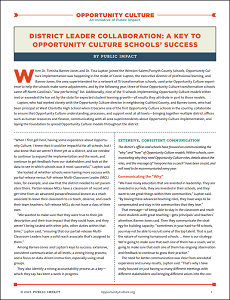The Latest from Public Impact®
When Dr. Tina Lupton and Dr. Timisha Barnes-Jones joined the Winston-Salem/Forsyth County Schools, Opportunity Culture® implementation was happening in the midst of Covid. Lupton, the executive director of professional learning, and Barnes-Jones, the area superintendent for a network of 15 transformation schools, used their experience in other Opportunity Culture® districts to help the schools make some adjustments. By the following year, three of those Opportunity Culture® schools came off North Carolina’s “low-performing” list; nine of the 11 schools implementing Opportunity Culture® models either met or exceeded the bar set by the state for expected student learning growth—results they attribute in part to these models.
Lupton, who had worked closely with the Opportunity Culture® director in neighboring Guilford County, and Barnes-Jones, who had been principal at West Charlotte High School when it became one of the first Opportunity Culture® schools in the country, collaborate to ensure that Opportunity Culture® understanding and support exist at all levels—bringing together multiple district offices such as human resources and finance, communicating with all area superintendents about Opportunity Culture® implementation, and laying the foundation to spread Opportunity Culture® models throughout the district.
Read our pieces highlighting their district-level work and the stories of two of the Opportunity Culture® schools here.

Opportunity Culture® Explained
A Complete Opportunity Culture®, For All: Summary —Research shows that educators in Multi-Classroom Leadership roles lead teaching teams to move from achieving average student learning growth to growth like or approaching that of top teachers. This two-page brief explains how a complete Opportunity Culture® model can maintain these results and extend them to all preK–12 students and both current and aspiring educators.
How Innovative Staffing Can Address Teacher Shortages, Permanently—and Boost Learning—Staffing shortages have plagued some schools for decades. How can innovative staffing designs help—and boost learning? The Opportunity Culture® initiative offers schools new tools to address staffing shortages, including high-paying advanced roles, improved support for new teachers, and staffing models that do not require filling every teacher vacancy to ensure that students have access to excellent instruction.
Understanding the Opportunity Culture® Principles—This two-page guide helps schools and districts implementing Opportunity Culture® school models and roles interpret the five Opportunity Culture® Principles. The principles help schools ensure that roles extending the reach of excellent teachers and principals to far more students, and to their colleagues, are sustainable and effective.
Paid Educator Residencies, Within Budget: How New School Models Can Radically Improve Teacher And Principal Preparation—This brief details how to create paid, full-time, yearlong residencies for aspiring teachers and principals, within existing budgets. Aspiring teachers become part of a Multi-Classroom Leadership team, while aspiring principals receive intensive coaching and support from a multi-school leader and a team of principals.
An Excellent Principal for Every School: Transforming Schools Into Leadership Machines—This idea paper lays out a vision for how districts can reach dramatically more students with great principals, for much higher pay, within budget—giving principals a career path that keeps them connected to students and schools through the Multi-School Leadership role.
Excellent Teaching for Every Young Child: Opportunity Culture® in Early Childhood Education—How could far more children ages 0–5 who are in early childhood education and care settings have consistent access to excellent teaching? Opportunity Culture® models can also be applied to early childhood settings. Public Impact®’s vision brief explains how, and shows the potential benefits for students, educators, and the country.
Opportunity Anew: How Excellent Educators Can Lift Up Their Colleagues, Students, and the Nation in the Wake of Covid-19—In the wake of Covid-19, the U.S. preK–12 education system needs more than a refresh. We need to think anew. This brief recommends the means through federal policy to bring critical, effective instructional and emotional supports to millions of teachers and their students—for a price tag the country can not only afford, but sustain long-term.
The Science of Reading
The Science of Reading Introduction: Understanding the Simple View of Reading —This introductory slide deck details the simple view of reading equation—Decoding X Language Comprehension = Reading Comprehension—and distinguishes misleading conventional wisdom from facts based on research about teaching methods that boost students’ reading comprehension. Start here, then turn to the Study and Action Guide for a structured process to put the science of reading into action. For speaker notes, see here.
The Science of Reading Study and Action Guide: Improving Your Multi-Classroom Leadership Team’s Instruction—This guide is intended to help Multi-Classroom Leaders, their teaching teams, and other teachers improve reading instruction and student learning growth fast. This short slide deck provides a structured process and action planner for improving curricula and teaching methods based on research, to improve reading instruction over one year, or faster by targeting critical instructional gaps. For speaker notes, see here.
The Science of Reading Part 1: Reading Comprehension Overview—Part 1 of this three-part training series providing guidance on the latest research in reading comprehension defines the elements of reading comprehension and why each matters, and identifies ways that teachers in all content areas can develop students’ comprehension skills. For speaker notes, see here.
The Science of Reading Part 2: Explicit Comprehension Instruction—Part 2 of this three-part training series providing guidance on the latest research in reading comprehension focuses on a critical, research-based approach to supporting students’ textual meaning-making. For speaker notes, see here.
The Science of Reading Part 3: Multi-Classroom Leader®/Team Leader Study and Action Guide—Part 3 of this three-part training series providing guidance on the latest research in reading comprehension identifies the next steps for systematically improving your team’s explicit comprehension instruction together. For speaker notes, see here.
For a list of all our publications, arranged chronologically, click here.
